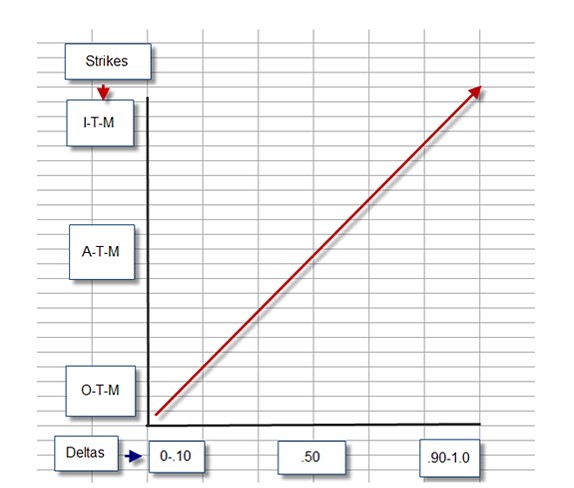“What is the best Delta to use when selling covered call options?” I get this question frequently from the educated core of members from our BCI community. Delta is one of the five option Greeks which are mathematical means of quantifying the risk inherent in our option positions. Delta is one of, what I consider, the “big 3”, with Vega and Theta being the other two. When responding to this question, I realized that my response was similar to a strategy I use when deciding when I should leave my house to get to the airport, a determination I have been making quite frequently as I have been speaking about option-selling almost every month in different cities throughout the US. First, I will provide the three definitions of Delta and then present my airport strategy.
Delta defined from three perspectives
- Delta is the amount an option price will change for every $1.00 change in share price.
- Delta is the equivalent number of shares represented by the options position.
- Delta is the percentage likelihood that, upon expiration, the option will expire in-the-money or (stated differently) with intrinsic value.
Many consider Delta the most significant of the option Greeks because option buyers depend on Delta to overcome the negative impact of Theta (time value erosion) in order to generate option profits. This would relate to the first of the three definitions. The second definition is important for those who are measuring overall portfolio risk as many wealth managers seek to approximate “Delta-neutral” portfolios. We, however, are option sellers so we consider the third definition which will determine the chance of exercise…the higher the Delta, the greater the chance of exercise unless we implement one of our exit strategies.
We also know that high-Delta options have an intrinsic value component as these strikes, by definition, are in-the-money. Intrinsic value offers greater protection to the downside but will eliminate the opportunity for additional profits from share appreciation as opposed to low-Delta options (out-of-the-money). These last two paragraphs represent the information we need to know and understand before making option decisions based on Delta. By now, you’re probably wondering what all this has to do with an “airport strategy”
Alan’s Airport Formula
This is all about working backwards, the same way we would determine option Delta decisions. When Linda and I are heading to the airport for a seminar in another city, we decide the night before when we should set our alarm clock. We start with our ultimate goal…be on the plane for an 11 AM takeoff, for example. Start with our end goal and then work backwards. Let’s see now:
- We like to get to the airport 2 hours before the flight leaves
- It takes 30 minutes to get from the airport parking lot to the terminal
- It takes 45 minutes to get to the airport parking lot
- We need one hour to shower and dress and load suit cases into our car
That’s 4 hours and 15 minutes which means we set the alarm clock at 6:45 AM for an 11 AM flight. That’s the best time to achieve our ultimate goal to be on the plane for an 11 AM takeoff. We worked backwards.
Practical application of selecting our option Delta using the “Airport Formula”
The key takeaway here is that our ultimate goal will vary based on several factors and so one particular Delta will not benefit us in all circumstances. Here are the factors to consider as they relate to Delta:
- What is our overall market assessment?
- What do the chart technicals tell us?
- What is our personal risk tolerance…high, low, somewhere in between?
Once we have made these determinations we make a portfolio assessment ranging from bullish to neutral to bearish. The more bullish we are, the lower Deltas would prevail. The more bearish we are, the higher Deltas would be more appropriate. We do not start with a specific Delta, but rather work backwards to be sure we achieve our goal of getting on that plane on time or setting our portfolio up based on current information. Generally, we look to near-the-money strikes that meet our initial monthly goals (2-4% in my case) so Deltas would range from 40 – 60 as a guideline. If bullish, we would move the range lower and, if bearish, we would favor a higher range. The chart below highlights a graphic representation of Delta (not the airline!) as it relates to the moneyness of the strike:

Discussion
Market tone
Global stocks declined this week as tensions between North Korea and the United States intensified. Oil prices decreased modestly, as West Texas Intermediate crude declined to $48.20 a barrel from $49 a week ago. Volatility, as measured by the Chicago Board Options Exchange Volatility Index (VIX), rose to 15.51 from 9.90 last Friday. This week’s economic and international news of importance:
- Donald Trump warned North Korea that its continued threats, if carried out, would be met with overwhelming force
- North Korea announced it was planning to target the waters surrounding the US territory of Guam with four missiles. Trump responded by noting US military plans are now “locked and loaded”
- Earlier this week intelligence assessments became public revealing that North Korea has likely acquired the technological capability to miniaturize a nuclear warhead, making it deliverable by missile
- Tensions have risen further in the wake of additional United Nations sanctions against North Korea that were unanimously agreed upon by the UN Security Council. The sanctions aim to cut North Korean exports by one-third and ban exports of coal, iron ore and seafood
- The Consumer Price Index rose just 0.1% in July after not rising at all in June, the fifth straight month of below-forecast inflation figures. Futures markets forecast just a 40% chance of another rate hike before the end of this year.
- The newly created Constituent Assembly this week declared itself supreme over all other branches of Venezuela’s government. A growing list of governments, including the US and the European Union have declared the assembly illegitimate
- Jacob Zuma, the embattled president of South Africa faced the fourth no-confidence motion of his presidency on Tuesday
- As of 9 August, 447 of S&P 500 companies have reported earnings for the second quarter. Earnings for the index are expected to rise 11.9% compared with the same quarter a year ago, and 9.2% when stripping out energy companies
- Revenues are seen up 5.1% versus Q2 2016, 4.1% ex-energy
For the week, the S&P 500 moved down by 1.43% for a year-to-date return of 9.05%
THE WEEK AHEAD
Mon, August 14th
- Japan: Q2 Gross domestic product
- China: Retail sales, industrial production
- Eurozone: Industrial production
Tue, August 15th
- United Kingdom: Consumer price index
- United States: Retail sales
Wed, August 16th
- Eurozone: Q2 Gross domestic product
- US Housing starts and building permits
Thu, August 17th
- UK: Retail sales
- Eurozone: CPI, trade, ECB minutes
- US Industrial production
- Canada: CPI
Summary
IBD: Uptrend under pressure
GMI: 3/6- Buy signal since market close of July 13, 2017
BCI: I am currently moving to a defensive posture as the September contracts approach, favoring in-the-money strikes 2-to-1. This position may change depending on the geo-political events that surface in the upcoming week.
WHAT THE BROAD MARKET INDICATORS (S&P 500 AND VIX) ARE TELLING US
The 6-month charts point to a mixed outlook. In the past six months, the S&P 500 was up 5% while the VIX (15.51) moved up by 40%.
Much success to all,
